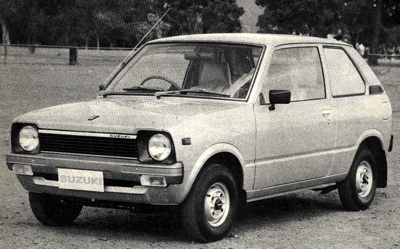Suzuki Hatch
Reviewed by Unique Cars and Parts
Our Rating: 1
Introduction
The original Suzuki Hatchback was marketed as a commercial vehicle; the reason was simple, at the time the government was enforcing a strict quota on imports, however “Commercial” vehicles were not subject to the quota. As a commercial vehicle it escaped the Federal Government's 57.5% import duty, thus giving it such a low initial purchase price. It came in at around 35% duty and avoided the quota problem. Besides, referring to is as a commercial vehicle also helped explain the little Suzuki’s lack of creature comforts and utilitarian nature.
In standard form the car had two front bucket seats, blanked in flanks and a small, flat cargo area with rear access through the bumper-height hatch. It was far from being a beauty to behold, with styling rather like the
Honda Scamp, however it was powered by the diminutive 543cc three-cylinder engine making it the perfect 2nd car or city run-about for those that sought good fuel economy. Using a paltry 4.4 litres per 100 kilometres, the Suzuki Hatch was a frugal as it was cheap to buy – and many saw that as a good thing.
The three cylinder water cooled four stroke engine produced 19.2 kW at 6000 rpm, and 35 Nm at 4000 rpm. It drove through the front wheels - cross-ply shod - via a four speed manual box (with floor shift). Suspension was coil and strut at the front, rather crude leaf spring at the back - remember though, the latter was as result of its commercial application. Steering was recirculating ball, and
brakes four wheel drum.
The side window blanks - which were fibreglass - could actually be deleted and a window kit optioned, bringing it a step closer to a 'car'. The only other option was
air-conditioning. Inside, the dash was finished in simple, durable black plastic, its layout being both functional and attractive. The driver faced two gauges, a speedo (marked to 120 km/h) and a fuel level/water temp/warning light cluster. A right hand stalk controlled indicators/high beam, a dash switch worked the lighting and a hard to reach stump (on the left of the steering column) the wiper/washers. Heater controls, ashtray and standard push-button radio were located in the centre dash area.
Control pedals were light, the gearshift fell easily to hand, as did the between-seats handbrake, and the floors were covered in rubber matting. Vinyl trimming was used on the doors and seats, and carried through to the back, as was the roof lining. A tubular steel cargo divider was bolted in just behind the fully adjustable buckets - whose fore/aft movement gave enough room for even a six footer - and was easily removable.
Not The Buzz-Box You Would Expect
Far from being the little buzz-box you'd expect, the Suzuki was in fact, quite the opposite. Its comfortable driving position allowed it to be handled surprisingly quickly and easily. Those that owned, or had at least driven the car, understood why it became so popular - so much so that in many markets throughout the world demand exceeded supply, even in its home market of Japan. But it was always a car that required compromise; to ensure compliance with its commercial vehicle status there were only two seats fitted, and there were no side in the rear (although they were optional).
The single overhead cam engine proved ideal for city traffic, but did require a degree of aggression to ensure you got the most out of it, while the rubbery four speed
manual transmission was a less than friendly device. Working the engine hard, in combination with prudent use of the gears would ensure the little Suzuki was not a traffic hazard to other motorists. From a handling point of view, it never handled or rode as well as a car, perhaps due to the use of commercial light truck cross-ply
tyres – thankfully radials were also an option. Like most other front wheel drive cars, the Hatch suffered typical understeer, and simply did not have enough power to provoke it any other way.
The front strut and rear leaf spring
suspension offered a decent ride, but the
handling was never anything to write home about. The front wheel drive configuration naturally meant understeer. On its standard crossplies the Hatch was easy to slide, but at least it was predictable. Road testers were almost unanimous in finding the steering vague and imprecise. The
brakes were not great either, although it was no surprise given they were drums all round. The rear “hatch” or “cargo” door opened nice and wide, providing a sizeable cargo area given the length of the car. As you would have expected on a commercial vehicle, the floor was covered with vinyl, as were the seats, but thankfully the addition of an AM radio allowed you to listen to the latest top 40, provided the reception was good.

The Suzuki Hatch - cheap to own and run.
|
Other worthwhile attributes included reasonable vision, the twin exterior mirrors removing the blind spot created by the filled-in sides. Seats were a disappointment though - being too soft and spongy in the Datsun Sunny mould. But, with a list price of $3995, the Suzuki Hatch was both insanely cheap and outstandingly economical. Sure it was being marketed as a commercial vehicle, but there was far more potential than that. The Suzuki Hatch made a great city runabout or delivery vehicle, but its main feature was the price. Those seeking a half decent ride inevitably looked elsewhere.
The Suzuki Hatch Economy Run
When the Suzuki Hatch was launched, the Southern distributors, MW Motors, organised a 30 km economy run, and on the first of a chaotic two day Melbourne transport strike, the release proved the amazing consumption obtainable. The average amoung the numerous motoring journalist drivers was 2.8 1/100 km (98.5 mpg), while the worst was 3.2 1/100 km (87.2 mpg). Just as thought provoking as the fuel consumption (or lack of it) was the price - only $3995. This compared favourably with its nearest competitor, the
Daihatsu Charade, which was around $4500. MW Motors also embarked on their own fuel economy run to Sydney and back. With driver, observer and overnight luggage aboard, the Hatch covered the 893.1 km distance for a return of 4.4 litres/100 km (64.5' mpg). Translated into costs, that equalled $30 of petrol (at 1978 prices) and included the full tank at the end of the trip.
A Hot Suzuki Hatch
A special pack that not only lifted the power and performance of the Suzuki Hatch but also cut fuel bills even further was introduced by M. W. Suzuki in Victoria in
1981. Size of the three-cylinder four-stroke
engine went up from 543cc to 796cc with the "800 pack" giving a 53.7 percent boost in power and a 67 percent lift in torque. But fuel consumption was claimed to be cut by 10 percent, according to tests run in Japan. At an average of 60 km per hour the Suzuki 800 returned 69.56 miles a gallon (4.05 litres to 100 kilometres). And in a series of runs through heavy peak hour traffic in downtown Tokyo, the Hatch recorded 50.62 mpg.
Part of the secret lay with the four-speed gearbox, which ran higher gearing with third gear in the 800 model almost matching the maximum speed in top of the 543cc Hatch. The 800 pack, which cost A$495, also included steel-belt radial
tyres, ventilated wheels up from 10-inch to 12-inch, front wheel disc
brakes and bolder bumpers front and rear, radio, laminated windscreen and fully-adjustable bucket seats are standard. Integrated
air-conditioning was available for A$645 on both the 800 and 543cc HATCH models. Fitted with the 800 pack, the HATCH cost A$4490.




It runs, well but does need a little cosmetic work done.